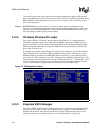
5-10
Celeron™ Processor Development Kit Manual
BIOS Quick Reference
The software on the target can be any terminal emulation program that supports ANSI terminal
mode, using 9600 baud, no parity, and one stop bit (Note: This can be modified by the OEM during
BIOS adaptation.) The program must be set to not use flow control, or the console may seem to
stall or not accept input.
Caution: HYPERTERMINAL’s default setting is to use flow control, which will render the console
inoperative. To change this, create a new session, change the flow control setting to “none”, save
the session, and exit HYPERTERMINAL. Then reinvoke HYPERTERMINAL with the session
and it will operate with the new flow control setting.
5.10.2 CE-Ready Windows CE Loader
Your system’s BIOS is “CE-Ready” and can directly boot Windows CE* without loading an
intermediate operating system such as DOS and LOADCEPC. Instead, the NK.BIN file can be
placed on a disk drive or drive emulator, and then the BIOS can be configured through the Basic
CMOS Configuration Setup Screen to boot the NK.BIN file from the boot drives instead of the
boot records on those drives.
To configure your system to boot Windows CE natively from a disk drive, set the “Boot Method”
field to “Windows CE” in the Basic CMOS Configuration Setup Screen. Then, place a copy of
NK.BIN suitable for execution by LOADCEPC in the root directory of your normal boot drive,
such as drive C:. Then, reboot the system. The configuration box should be displayed (Figure 5-8),
and immediately following should be the message “Loading Windows CE…” followed by a series
of dots, indicating that the loading process is continuing. Once fully loaded, Windows CE takes
over the system and runs using the standard PC keyboard, screen, and PS/2 mouse.
5.10.3 Integrated BIOS Debugger
The system’s BIOS contains a built-in debugger that can be a valuable tool to aid the board bring-
up process on new designs similar to the evaluation board. It supports a DOS SYMDEB-style
command line interface, and can be used on the main console’s keyboard and screen, or over a
redirected connection to a terminal program (see “Console Redirection” on page 5-9).
Figure 5-8. CE-Ready Boot Feature


















